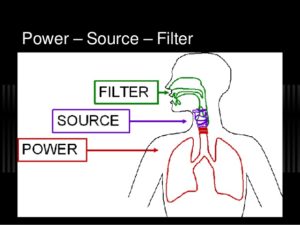Resonance - Articulation - Sound Production part 2
I thought it’s time for another round of voice physiology. If you haven’t read part one yet, here's the link to Voice Production and to Resonance. Have you ever wondered how we produce sounds (for both speech and singing). Or how we create different vowels and consonants? In order to answer these questions, we will take a look at the Source-Filter Theory.
The Source-Filter Theory
The Source-Filter Theory describes the articulatory and resonance system. This theory describes speech production for vowels as a two stage process. The first part is the Source: As air moves from the lungs through the glottis (the gap between the vocal folds when they are open), the vocal folds start vibrating. They create a buzzing sound. The vibrating vocal folds on their own (if we wouldn't have a head, ha) would not make much sound. That's why we need an acoustic space, to amplify the sound wave created by the vocal folds. This is where the pharynx and our mouth come in (=the filter). The second part is the Filter: as the sound travels up the pharynx, into your mouth and out of your mouth certain frequencies are boosted and others are attenuated.
Depending on the shape of your mouth, tongue position, soft palate and pharynx, vowels can be shaped. This is why we can produce different vowels. By changing the shape of our articulators (and changing the filter).
How does the theory apply to Consonants?
In order to distinguish consonants, we use movable articulators like the tongue, lips, mandible and the soft palate, as well as immovable articulators like the teeth, hard palate and alveolar ridge. The movement of the articulators shape the cavities of the vocal tract and determine the sound which comes out at the lips.
Vowels
Vowels in English are identified by horizontal tongue position (front, central, back) and vertical position of the tongue (high, mid, low), as well as the degree of lip rounding and tongue tension. The four corner vowels /i/, /u/, /a/ and /ae/ for example are high-front (/i/), high-back (/u/), low-front (/a/) and low-back (/ae/).
Why do we care about that for singing?
When we sing we want to stay away from the extremes. We neither want our vowels to be too narrow, nor do we want them to be too wide. This has to do with formants and harmonics. I will make an attempt to explain this in more detail in another post, but for now know that you want to keep your vowels as centered as possible. This means that you might have to open up certain corner vowels such as the /i/ and the /u/ or close up some of the open vowels such as the /a/. Otherwise certain vowels might 'pop up' too much or 'fall back' and temp you to 'pull up' chest voice or 'let go' into falsetto. Do you have any questions in regards to singing? What do you wanted to know in regards to singing and the voice? Just ask us: contact@vocals-on-stage.comLike us on Facebook Find us on Yelp




